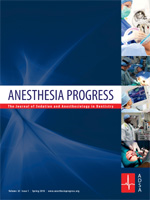
Anesthesia Progress Volume 68 Issue 1
Finding the correct mixture of medications with the least number of adverse events for this type of sedation is a key factor in the success of the procedure.
LAWRENCE, Kan. (PRWEB)
April 15, 2021
Anesthesia Progress – It is increasingly more common for pediatric patients to require general anesthesia (GA) for dental procedures; however, uncooperative patients or those with mental disabilities add a greater challenge. Children, particularly those with special needs, often require intramuscular (IM) sedation for safe and effective transport into the operating room and induction of GA for dental procedures. Finding the correct mixture of medications with the least number of adverse events for IM sedation is a key factor for successful management of these patients.
Researchers from the Stony Brook School of Dental Medicine and the Renaissance School of Medicine at Stony Brook University, Stony Brook, New York, published a retrospective study in the current issue of Anesthesia Progress to analyze the effectiveness and safety of two IM sedative combinations for pediatric dental procedures.
A total of 105 patients who were treated by dental anesthesiologists at the Stony Brook University Hospital between January 1, 2016 and January 1, 2019 met the criteria to have their charts reviewed by the researchers. Of the patients, 59% were younger than 13 years, and 64% had at least one behavioral issue, with autism spectrum disorder being the most common. The researchers compared the charts to determine if IM injection with a combination of ketamine and dexmedetomidine (KD) was safer than IM with ketamine and midazolam (KM).
The researchers found no difference in the time from IM administration to operating room entry in either group. There was also no difference between groups regarding adverse events. There was a notable difference when measuring mean arterial pressure (MAP) and heart rates (HR) as the KD group showed significantly reduced minimal MAP, minimal HR, and maximum HR compared with the KM group. There was a slight increase in the time from IM injection to patient discharge in the KD group (273 vs. 240 minutes) as well as a longer median duration of surgery (145 vs. 130 minutes); however, neither of these differences were shown to be statically significant.
The researchers conclude that IM administration with ketamine and dexmedetomidine is an effective and safe alternative compared with ketamine and midazolam for facilitating patient transfer into the OR and inducing GA. They also suggest that performing additional randomized clinical trials would provide more data, especially relating to assessing accurate dosing options.
Full text of the article, “Retrospective Comparison of Intramuscular Admixtures of Ketamine and Dexmedetomidine Versus Ketamine and Midazolam for Preoperative Sedation,” Anesthesia Progress, Vol. 68, No. 1, 2021, is available at https://meridian.allenpress.com/anesthesia-progress/article/68/1/3/463660/Retrospective-Comparison-of-Intramuscular.
###
About Anesthesia Progress
Anesthesia Progress is the official publication of the American Dental Society of Anesthesiology (ADSA). The quarterly journal is dedicated to providing a better understanding of the advances being made in the science of pain and anxiety control in dentistry. The journal invites submissions of review articles, reports on clinical techniques, case reports, and conference summaries. To learn more about the ADSA, visit: http://www.adsahome.org/.
Share article on social media or email:

